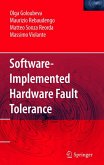This book covers the study of computational methods, computer arithmetic algorithms, and design improvement techniques needed to implement efficient cryptographic algorithms in FPGA reconfigurable hardware platforms. The concepts and techniques reviewed in this book will make special emphasis on the practical aspects of reconfigurable hardware design, explaining the basic mathematics related and giving a comprehensive description of state-of-the-art implementation techniques. The authors show how high-speed cryptographic algorithms implementations can be achieved on reconfigurable hardware devices without posing prohibited high requirements for hardware resources. The material in this book will be of interest to engineering professionals, programmers, hardware designers, and graduate students interested in the development of security and cryptographic mechanisms at a beginning/intermediate level.
Dieser Download kann aus rechtlichen Gründen nur mit Rechnungsadresse in A, B, BG, CY, CZ, D, DK, EW, E, FIN, F, GR, HR, H, IRL, I, LT, L, LR, M, NL, PL, P, R, S, SLO, SK ausgeliefert werden.
Hinweis: Dieser Artikel kann nur an eine deutsche Lieferadresse ausgeliefert werden.









